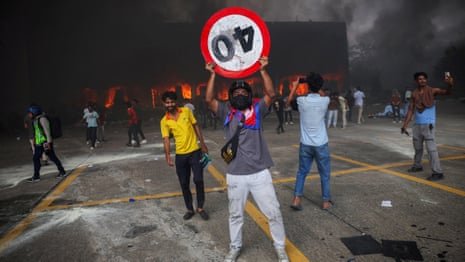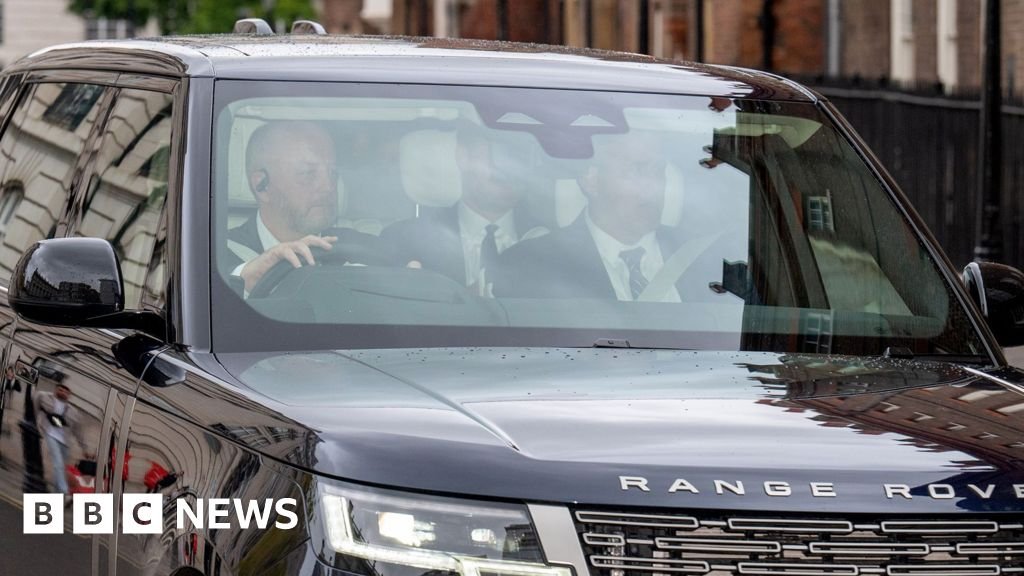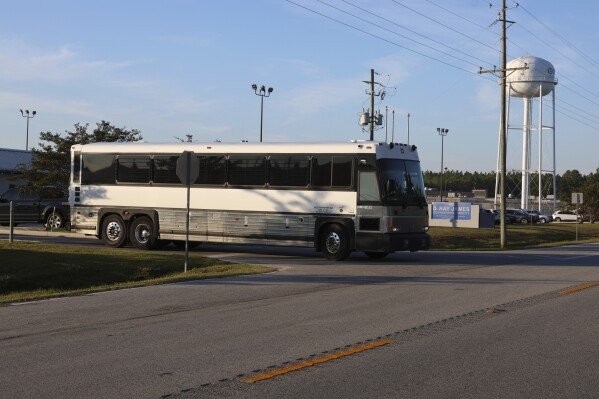Top Stories
‘This is our revolution. It’s our turn now’: Nepal’s ‘gen Z protesters’ speak out against corruption | Nepal

The whiteboard listing the names of patients at a hospital in central Kathmandu tells the story of a protest gone badly wrong. Beside each name is written their ages; 18, 22, 20, 18, 23. The list goes on.
By Wednesday morning there were still scores of Nepal’s young being treated for gunshot wounds and injuries sustained when police opened fire on protesters in Kathmandu on Monday.
These are the so-called gen Z protesters, a generation of young Nepalis who led a mass protest against government corruption, nepotism and a ban on social media sites, and paid for it with bullet wounds and in some cases their lives. Hundreds were injured and at least 22 are believed to have died.
From his hospital bed, Saurav*, an 18-year-old college student, said he had been excited to join the protest. “When it comes to the nation, there is no need for motivation. The politicians are just selling our country for their own greed. That’s not supposed to happen,” he said.
The violence that broke out before the police opened fire on the huge crowds that had gathered outside the parliament building in Kathmandu on Mondays was, insists Saurav, instigated by groups outside their anti-corruption movement.
As the shooting started, a protester standing in front of Saurav was shot in the chest and died on the spot, he said. Pellets from the shot hit his hand. “I was screaming in pain and my friends carried me to this hospital … It was totally unnecessary. Killing people, I don’t think that’s humanity. That’s just disgusting,” he said.
By Tuesday afternoon the prime minister, KP Sharma Oli, had resigned and thousands of Nepalis had taken to the streets to spontaneously celebrate his downfall and express their anger.
The mood initially was one of jubilation at what many saw as the end of widespread government corruption, and bitter resentment at the killing of the protesters the day before.
For the past 10 years, Nepal has been ruled by the same three elderly leaders – Oli, Sher Bahadur Deuba and Pushpa Kamal Dahal – who have effectively taken up the post of prime minister on a rotating basis. Between them, they have led the country on 12 separate occasions. While yesterday’s protests may have been triggered by the government’s ban on dozens of social media sites last week, it was built on years of frustration and anger at politicians who are widely viewed as corrupt and self-serving.
By 4pm the main roads into the heart of the city were packed with protesters, many on motorbikes, chanting, shouting and waving the Nepali flag, in defiance of a government curfew. Many more lined the streets, filming the moment and taking selfies, sensing that history was being made.
Much of the anger was directed at Oli, with handwritten signs scrawled on walls and T-shirts calling for him to be killed. “He killed our youth. He should be dead,” said one.
The focus of the crowds was Singha Durbar, the complex of government ministries, which was then breached and much of it set on fire. One group drove a police van out of the main gate, carrying dozens of triumphant protesters on its roof. Three young men scaled the ornate entrance gate to wave the national flag. On the ground below, a group belted out the national anthem. A small number of soldiers stood by but did little to intervene. There was no sign of the police.
As thick, acrid smoke belched out across the streets and over the city, some protesters emerged from the burning buildings carrying reams of paper, office chairs and computer monitors.
“This is a revolution. This is the end of the corruption. It’s our turn now,” said Sujan Dahal, a young Nepali celebrating the downfall of the prime minister in Kathmandu on Tuesday. “The government was so corrupt. They used that money to improve their own lives, but there has been no change in the lives of normal people.”
By the end of the day, the scale of destruction had shocked many Nepalis, amid a sense that the movement has been sabotaged by groups seemingly bent on retribution and violence.
“I’m feeling bad. This is not good for us,” said a young man, who did not want to give his name. Along with government ministries and residences, dozens of other properties have been set on fire across the city, including a luxury hotel and a prestigious private school.
Throughout the day, groups of protesters had formed human chains around some sites to protect them, including the entrance to an army camp. “We are protecting the army. We are not against the army. We are against the government. The corruption. They are trying to shut our voices by stopping social media. Today we won. It is our victory. Oli has resigned,” said Sajad Ansari, 20.
By Wednesday morning, the administrative heart of Kathmandu looked like the aftermath of a missile attack. Burnt-out buildings stood smouldering in the light rain. The charred shells of cars and motorbikes lay strewn across the streets. Plumes of dark smoke still rose over the city.
The city is now in a state of almost complete lockdown, with soldiers stationed at major junctions enforcing a strict curfew.
It is unclear what shape a future government might take.
It is a sentiment shared by Saurav even as he recovers from his injuries but, like many, he remains optimistic. “If the power is in the right hands, of course Nepal will develop,” he said. “Our young generation are very capable. We don’t seek for our own greed. We think about the good of the nation.”
* Name has been changed
Top Stories
Travis Kelce explains ‘frustrating’ collision that resulted in Xavier Worthy injury

Kansas City Chiefs tight end Travis Kelce detailed the “frustrating” play in which he collided with Xavier Worthy and sent the wide receiver to the sideline for the majority of the Chiefs’ loss to the Chargers on Wednesday’s episode of the “New Heights” podcast.
“I’m supposed to be running my route at depth for Worthy,” Kelce said. “I was trying to kind of set up my guy to be able to get into position, and it all just happened pretty quick. I just got to be better, man. I’m 13 years in the league, there’s no excuse for me running into my own guys like that.”
Kelce said Worthy “had his guy beat” and if the collision hadn’t happened, “the game starts completely different.” Worthy was ruled out with a right shoulder injury shortly after the play. The Chiefs never led the Chargers in the 27-21 defeat in Brazil on Friday.
“(Worthy’s) one of our best players, he’s going to take that step to be one of the best receivers in the National Football League, and I run into him and all of a sudden one of the biggest pieces of the game plan is out of the game,” Kelce said. “One of the fastest guys in the league — speed kills in this league — now they (the Chargers) don’t have to worry about that.”
On Wednesday, head coach Andy Reid said neither surgery nor injured reserve — which would keep Worthy out for at least four weeks — is being considered. Reid said Worthy would not participate in practice on Wednesday and his status is day to day.
“Those two won’t practice today,” Reid said Wednesday, referring to Worthy and rookie wide receiver Jalen Royals. “Both are doing better. They’re working on it and making progress, but not ready to go today for sure.”
Earlier this week, Reid said, “As far as injuries go, I know Xavier’s (Worthy) the big question, and he’s rehabbing and working his shoulder. We’ll just see where it goes.”
Worthy was the Chiefs’ leading receiver last year as a rookie. He entered 2025 as the Chiefs’ top option, especially with Rashee Rice serving a six-game suspension for this role in a March 2024 high-speed crash. Kelce said he owes Worthy “big time,” and he could “barely even f—ing play the rest of that first half.”
“I literally took one of my players out. That’s one of the most frustrating parts, and it’s hard to get your juices back going knowing you just hurt a guy,” Kelce said. “It’s a frustrating way to start out the season. It’s a frustrating way to start out the game. You can take some good from that second half, but at the end of the day, man, we just got to be able to win up front, be accountable on the back end and be able to start fast and finish stronger.”
On Sunday, the Chiefs host the Philadelphia Eagles in a rematch of Super Bowl LIX.
(Photo: Amanda Perobelli / Reuters via Imagn Images)
Top Stories
Prince Harry meets King Charles for first time in over a year

Prince Harry has met his father King Charles at Clarence House in London for the first time since February 2024.
It is understood the King had a private tea with his son during a 55-minute meeting this afternoon.
The King travelled down to London from Scotland on Wednesday afternoon – and Prince Harry has been in the UK this week for charity events.
There had been no face to face meeting between father and son since February 2024, with Prince Harry telling a BBC interview in May 2025: “I would love a reconciliation with my family.”
The meeting will be seen as a first step in improving relations between father and son and building trust in what has been a sometimes tense relationship.
The last time that father and son met were together was soon after the King’s cancer diagnosis last year, with Prince Harry flying to the UK for a brief meeting.
There have been visits to the UK by Prince Harry since then, including for court cases, but he had not seen his father, in what had seemed a deep family rift.
Prince Harry arrived back in the UK on Monday and has carried out a series of charity events in London and Nottingham – against a background of questions about whether there would be a meeting with his father.
He will be leaving the UK on Thursday, returning to the US to see Meghan and their children, who did not come on this trip.
Prince Harry has previously voiced his frustration at not being able to talk to his father, particularly when there were concerns about the King’s health.
“There’s no point continuing to fight any more, life is precious,” Harry said in his BBC interview.
The apparent meeting between the King and Prince Harry comes after rumours of efforts to resolve the family divide.
Representatives of Prince Harry and Buckingham Palace had been photographed together in a meeting in London in July, producing newspaper headlines about a “peace summit”.
But there have been no signs of Prince Harry meeting Prince William during this week, with the brothers carrying out separate arrangements.
On Monday, Prince Harry had laid a wreath at the grave of his grandmother, Queen Elizabeth II, on the third anniversary of her death.
Less than 10 miles away, Prince William and Catherine had attended a Women’s Institute meeting honouring the memory of the late Queen.
Top Stories
What to know: Fear lingers after Koreans detained during raid at Hyundai plant

POOLER, Ga. (AP) — After the detention of more than 300 South Korean workers in an immigration raid at a Georgia battery plant last week, a charter plane arrived in Atlanta on Wednesday to bring them home. But there has been no word on when the workers can leave, even after a high-level meeting between officials from the two countries.
The Koreans were among some 475 workers detained during last week’s raid at the battery factory under construction on the campus of Hyundai’s sprawling auto plant west of Savannah.
South Korea’s Foreign Ministry said Seoul and Washington were discussing details for the workers’ return. The State Department says Secretary of State Marco Rubio and South Korean Foreign Minister Cho Hyun highlighted the U.S.-South Korea alliance and strong relationship at a hastily arranged meeting Wednesday. In a statement that did not mention the arrests, the department said the meeting focused on strengthening bilateral ties and underscoring the importance of the alliance between Washington and Seoul.
Here are some things to know about the raid and its aftermath.
What efforts have been made to get the South Koreans home?
A Korean Air Boeing 747-8i departed from Seoul for the U.S. to bring back detained Korean workers and landed in Atlanta on Wednesday, but officials say its return won’t happen as quickly as they had hoped. South Korea’s Foreign Ministry said it was talking with U.S. officials about letting the plane return home with the released workers as soon as possible. But it said the plane cannot depart from the U.S. on Wednesday as South Korea earlier wished due to an unspecified reason involving the U.S. side.
The workers were being held at an immigration detention center in Folkston, in southeast Georgia, near the state line with Florida. It’s a 285-mile (460-kilometer) drive from there to Atlanta. Three buses were parked at the detention center Wednesday morning.
South Korean officials said they’ve been negotiating with the U.S. to win “voluntary” departures for the workers, rather than deportations that could make them ineligible to return to the U.S. for up to 10 years.
South Korean TV showed Cho Ki-joong, consul general at the Korean Embassy in Washington, speaking outside the detention center. He said some administrative steps remained to be completed but that things were going smoothly. The South Korean Foreign Ministry declined to comment on media reports that he and other diplomats met with detained workers.
What are the immigration consequences for the workers?
U.S. authorities have said that those detained during the raid were “unlawfully working” at the plant. But Charles Kuck, a lawyer representing several of the detained South Koreans, said the “vast majority” of the workers from South Korea were doing work that is authorized under the B-1 business visitor visa program.
A B-1 visitor for business visa allows foreign workers to stay for up to six months, getting reimbursed for expenses while collecting a paycheck back home. There are limits — for example, they can supervise construction projects but can’t build anything themselves — but if it’s spelled out in a contract, they can install equipment, Los Angeles immigration lawyer Angelo Paparelli said.
Also, South Korea is one of 41 countries whose citizens can use the U.S. Electronic System for Travel Authorization (ESTA), which provides a visa waiver if they can provide “a legitimate reason’’ for their visit, and this basically gives them B-1 visa status for up to 90 days, said immigration attorney Rita Sostrin in Los Angeles.
What effect has the raid had on the area around the plant?
In Pooler, a suburb of Savannah, the sprawling Hyundai electric vehicle plant has triggered noticeable growth.
Signs in shopping center parking lots point to homes for sale in new subdivisions nearby. Construction crews work on multistory apartment buildings while finished apartments in the same complex display large banners proclaiming they’re ready for new residents.
Meanwhile, a growing number of Korean restaurants and Asian grocery stores have found a home among standard American fast-food franchises and chain eateries like Starbucks and Cracker Barrel.
Ruby Gould, president of the Korean American Association of Greater Savannah, said there’s no question that last week’s raid has raised anxiety among the area’s Korean immigrants.
“People are very upset about the incident, the arrest of the workers,” Gould said. “I’m sure there are some people in fear about this visa situation after they witnessed what’s happened.”
The U.S. Census Bureau says Pooler’s population jumped to 31,171 last year, an increase of 21% since 2020. That period includes the groundbreaking and construction of Hyundai’s EV factory.
People of Asian origin made up just 6% of the suburban city’s residents in 2020. While newer demographic data isn’t available, people in the area say Korean Americans and South Korean immigrants make up a sizable share of recent newcomers.
Pastor Robin Kim and his wife closed last month on a new home in Pooler, where Kim is starting his own church. He left the Army a few months ago after serving as a chaplain to soldiers at nearby Fort Stewart. Kim said they wanted to be a part of the Savannah suburb’s growing Korean community.
Kim, 51, has sought to calm some of the anger and anxiety in the community since last week’s raid. He noticed fewer Korean people out shopping over the weekend, and reads a constant stream of messages posted in a chat group of 1,900 local Korean residents.
“The people feel like they’re being watched, like they’re being judged by the American people,” Kim said. “They are scared right now. They don’t want to be trouble.”
He said some are resentful at the U.S. government considering the billions of dollars Hyundai has invested in the Georgia plant and the thousands of U.S. jobs it’s creating. Others worry the immigration arrests will mean increased scrutiny that hinders their own efforts to extend visas or obtain green cards.
___
Brumback reported from Atlanta. Associated Press writers Hyung-Jin Kim in Seoul and Didi Tang and Paul Wiseman in Washington contributed to this report.
-

 Business2 weeks ago
Business2 weeks agoThe Guardian view on Trump and the Fed: independence is no substitute for accountability | Editorial
-
Tools & Platforms4 weeks ago
Building Trust in Military AI Starts with Opening the Black Box – War on the Rocks
-

 Ethics & Policy1 month ago
Ethics & Policy1 month agoSDAIA Supports Saudi Arabia’s Leadership in Shaping Global AI Ethics, Policy, and Research – وكالة الأنباء السعودية
-

 Events & Conferences4 months ago
Events & Conferences4 months agoJourney to 1000 models: Scaling Instagram’s recommendation system
-

 Jobs & Careers2 months ago
Jobs & Careers2 months agoMumbai-based Perplexity Alternative Has 60k+ Users Without Funding
-

 Podcasts & Talks2 months ago
Podcasts & Talks2 months agoHappy 4th of July! 🎆 Made with Veo 3 in Gemini
-

 Education2 months ago
Education2 months agoMacron says UK and France have duty to tackle illegal migration ‘with humanity, solidarity and firmness’ – UK politics live | Politics
-

 Education2 months ago
Education2 months agoVEX Robotics launches AI-powered classroom robotics system
-

 Funding & Business2 months ago
Funding & Business2 months agoKayak and Expedia race to build AI travel agents that turn social posts into itineraries
-

 Podcasts & Talks2 months ago
Podcasts & Talks2 months agoOpenAI 🤝 @teamganassi

